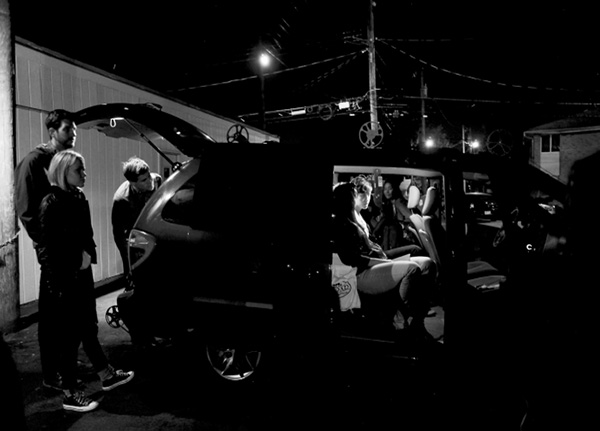
CARAVAN: DOUBLE FEATURE
first performed on September 19, 2014
Mote Gallery, Columbus, OH
performed five times in 2014
EVAN DAWSON / PAIGE PHILLIPS
Stephen Takacs, Liz Roberts
Marpha, Nepal
866621944e866621944v866621944n866621944.866621944d866621944w866621944s866621944n866621944@866621944g866621944m866621944a866621944i866621944l866621944.866621944c866621944o866621944m
CARAVAN: DOUBLE FEATURE
EVAN DAWSON / PAIGE PHILLIPS
Caravan: Double Feature presents a traveling performance and expanded cinema event that was created to address several different problems that to us were wound up in the 2001 Dodge Caravan that we owned.
Bricks could be seen in the back of the van, where the back row of seats had been removed to hold the cargo. They were found bricks, stolen or discovered over the course of many years. In the performance they were taken out with alternate movements to build a hearth, then stacked to form low stools around a hearth, then moved to arc around the film. With other synchronized movements we opened up the doors to create an entrance to the van, and manipulated the audience space with ropes as we made several circling passes. The key to the journey was a balance of energy; the car battery was the epicenter. Two more bricks, carefully placed on the gas pedal, charged the battery, while also making the wheels spin at an uncomfortably fast speed. The closed auto-electrical system was kept in motion with a delicate balance of power, as the 16mm film projectors which now sat in place of headlights pulled about as much electricity as the AC/DC converter could supply. The film lasted as long as the circumference of the car, and looped the wanderers forward for as long as the battery would last (approximately 20-25 minutes).
We had found our rising dependence on the car was structured into the design of the city, and that structure weighed on our efforts to make ends meet. So there was a personal problem and a city planning problem. More importantly, it was a relationship problem—the very mechanisms that are meant to close distances produce distances. Think about how many empty seats are sitting in traffic. In our estimating much of the culture feels a need to take short term gains to cope with their long term losses, even though it is a self-fulfilling prophecy. We felt a need to address this object in particular but it was also a stand-in for other forms of technology.
What we had at our disposal to address this vehicle and all of its baggage was a concurrent contemplation about our long-term commitment to each other, as we had decided to marry that same year. While it presented many tempting analogies, what it led us to instead was a sentiment described by Ludwig Mies van der Rohe: “Architecture starts when you carefully put two bricks together.” The thought was later picked up by Lawrence Weiner to address social structures, in which the brick becomes analogy for human relationship as material. Of course cars and cinemas can be different types of social spaces, but here they came together in a site of exchange that packed up and toured to five cities in the eastern United States.